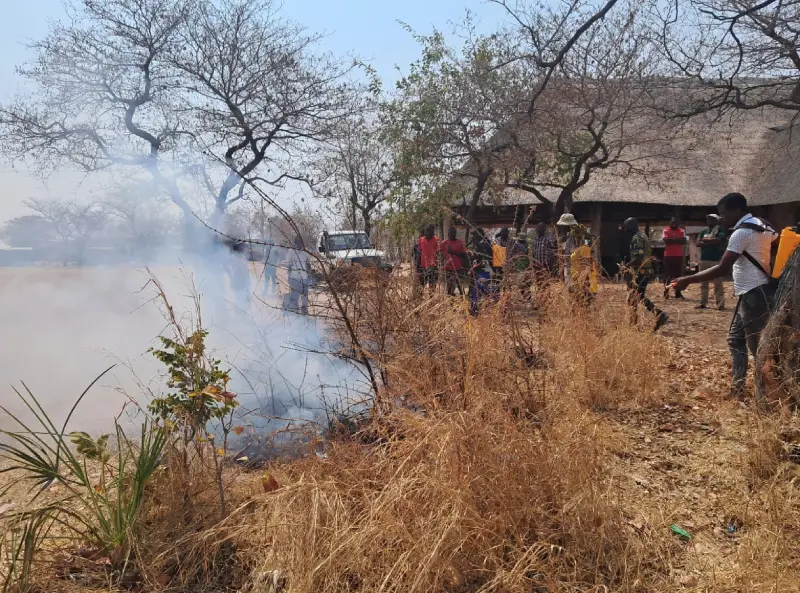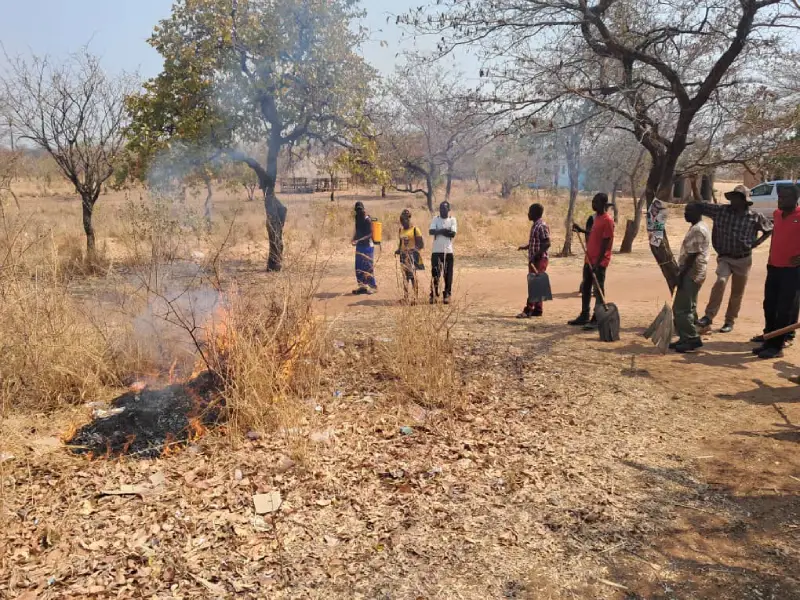Community-Led Wildfire Management Boosts Conservation, Sustains Livelihoods in Zimbabwe

Wildfire Management training in Mbire, in Middle Zambezi Valley, Zimbabwe.
In the semi-arid lands of Zimbabwe’s Mbire District, wildfires have long been a persistent challenge, decimating vegetation, endangering wildlife, and threatening the livelihoods of local communities. The region is part of the Middle-Zambezi Valley, a critical regional conservation landscape where ecosystems are vulnerable to both climatic and human-induced pressures.
Rutendo Jimu, 26, a community wildlife scout in the district, recalls the devastation vividly. “I used to feel helpless watching the fires spread unchecked,” she said. “It was heartbreaking to see not just our land, but our future, go up in flames.”
Mbire lies approximately 300 kilometers northwest of Harare and is a vital wildlife migratory corridor for species like elephants, African-painted dogs, lions, and leopards. This region, with temperatures often exceeding 40°C and annual rainfall averaging between 400 and 500 millimeters, faces severe drought conditions exacerbated by climate change.
Wildfires, primarily caused by human activities such as land clearing and the improper disposal of flammable waste like cigarette butts, have intensified in frequency and scale over the years. These fires not only destroy habitats but also force wildlife into human settlements, increasing the risk of conflict and threatening local livelihoods.
Community-Driven Response
In response, a collaborative initiative was launched in 2023 by the Mbire Rural District Council, Zimbabwe Parks and Wildlife Management Authority (Zimparks), Environmental Management Agency (EMA), Forestry Commission, and the African Wildlife Foundation (AWF). Backed by AWF support, the program delivered essential integrated fire management training to 223 participants, including local leaders, resource monitors, and community wildlife scouts like Jimu.
"The training empowered us with practical skills," Jimu explained. "Now, we know how to construct fireguards, safely extinguish wildfires, and teach other local community members about controlled burning."

Wildfire Management training in Mbire, in Middle Zambezi Valley, Zimbabwe.
The program emphasized the use of tools such as high-pressure knapsack sprayers and fire beaters while establishing communication systems to report and address wildfire outbreaks swiftly.
Measurable Impact
The results are promising. Mbire District, previously one of the most fire-affected districts in Zimbabwe’s Mashonaland Central Province, reported significant reductions in burned areas.
Data from Global Forest Watch indicates that from November 2023 to November 2024, the district recorded 26 high-confidence fire alerts using the Visible Infrared Imaging Radiometer Suite (VIIRS), a satellite system that tracks environmental conditions.
This marks a notable decrease compared to historical data, with the highest number of annual fire alerts recorded in 2018 when 173 alerts were reported. This decline highlights the effectiveness of recent fire management efforts in the district.
"Seeing these numbers decline is encouraging," said EMA District Environmental Officer Tendai Norman Makombe. "It shows that community engagement and proactive fire management work."
Jimu recounted her role in extinguishing a veld fire in Mbire’s Mazambara area. "Applying the training felt empowering," she said. "We saved not just land, but also the livelihoods that depend on it."
Strengthening Resilience
The initiative is part of a broader effort to build long-term resilience in Mbire. Plans are underway to establish village-level firefighting teams and promote local production of fire management tools. "We’re teaching communities how to make fire beaters using materials like animal hides," Makombe said. "This ensures sustainability, even without donor funding."
The program not only enhances the protection of critical habitats but also helps reduce human-wildlife conflict, as intact forests keep wild animals from straying into villages. "When wildlife remains within its natural habitat, both people and wildlife benefit," said Forestry Officer Francis Lunga.
Mbire also gains economically through CAMPFIRE (Communal Areas Management Programme for Indigenous Resources), a model that channels revenue from wildlife tourism and sport hunting back to communities. This revenue supports schools, clinics, and infrastructure, making wildlife conservation directly beneficial for local people.
"Forests and wildlife are critical assets," Lunga said. "Managing veld fires is key to preserving these resources for tourism and ecological balance."
Daniel Makaza, AWF’s Community-Based Natural Resource Management Officer based in Mbire, notes that the reduction in wildfires has sparked renewed hope in Mbire with local agriculture, food security, and vegetation regrowth all showing signs of improvement.
“We’re seeing stronger communities and healthier ecosystems,” Makaza shared. “This is more than fire management—it’s about securing our future.”